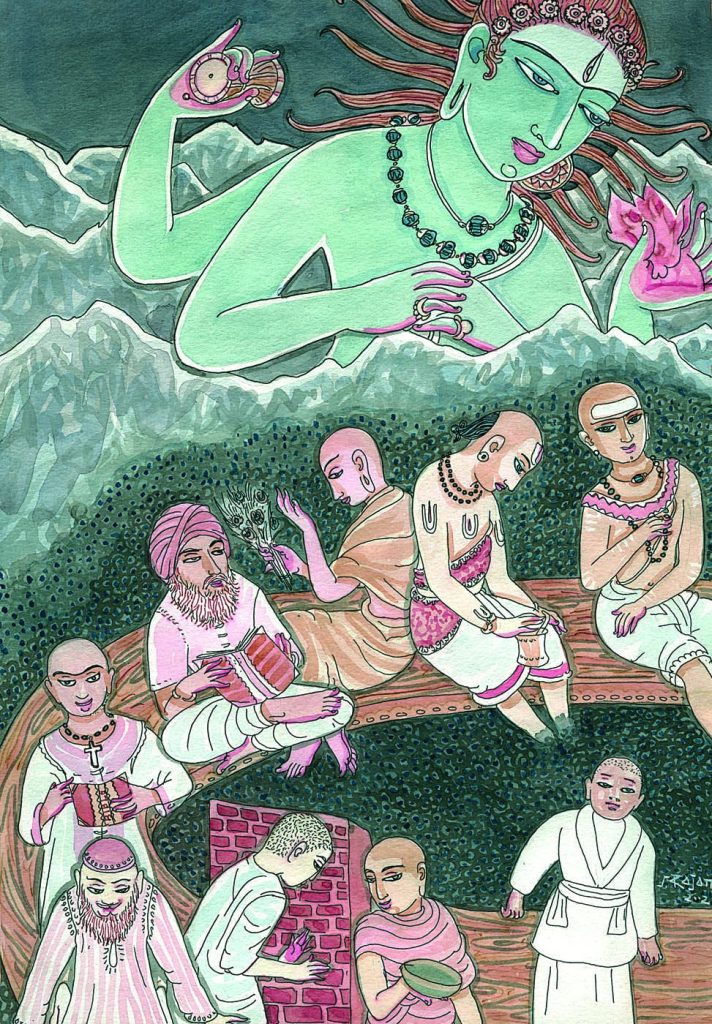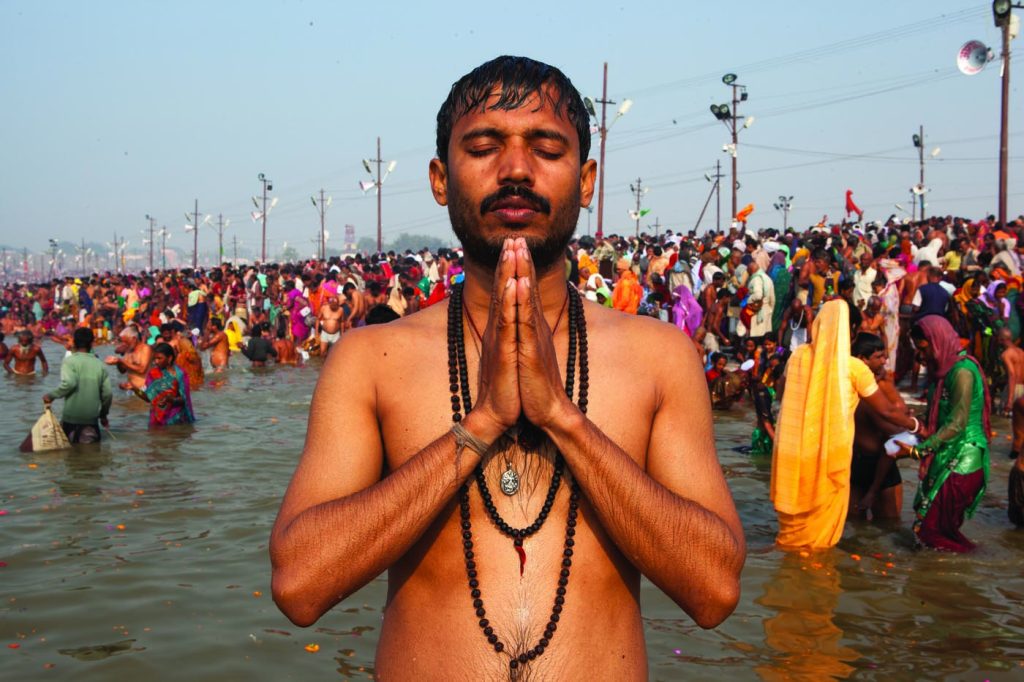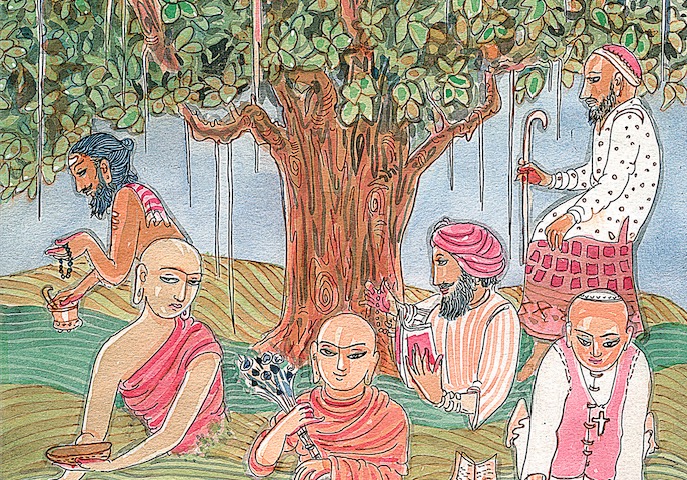A Presentation of Religious Beliefs, Goals, Paths Of Attainment & Ideological Comparisons
IF RELIGIONS HAVE EVER CONFUSED & CONFOUNDED YOU, take heart! This resource was written just for you. It is the humble attempt of the HINDUISM TODAY editorial team to gather from hundreds of sources a simple, in-a-nutshell summary of the world’s major spiritual paths. The strength of this undertaking, brevity, is also its flaw. Complex and subtle distinctions, not to mention important exceptions, are consciously set aside for the sake of simplicity. By juxtaposing their beliefs and goals, we hope to highlight how the various religions are similar to and different from Hinduism. An hour with these pages may dispel the myth that all religions are one, that they all seek to lead adherents by the same means to the same ultimate reality. That’s a myth. They don’t, as a conscientious review will show.


HINDUISM




Perishable is matter. Immortal, imperishable the Lord, who, the One, controls the perishable and also the soul. Meditating on Him, uniting with Him, becoming more and more like Him, one is freed at the last from the world’s illusion.
SHVETASVATARA UPANISHAD 1.1
Founded: Hinduism, the world’s oldest religion, has no beginning—it predates recorded history.
Founder: Hinduism has no human founder.
Major Scriptures: The Vedas, Agamas and more.
Adherents: Over one billion, mostly in India, Sri Lanka, Bangladesh, Bhutan, Nepal, Malaysia, Mauritius, Indonesia, Indian Ocean, Africa, Europe and North and South America.
Sects: There are four main denominations: Saivism, Shaktism, Vaishnavism and Smartism.
SYNOPSIS
Hinduism is a vast and profound religion. It worships one Supreme Reality (called by many names) and teaches that all souls ultimately realize Truth. There is no eternal hell, no damnation. It accepts all genuine spiritual paths—from pure monism (“God alone exists”) to theistic dualism (“When shall I know His Grace?”). Each soul is free to find his own way, whether by devotion, austerity, meditation (yoga) or selfless service. Stress is placed on temple worship, scripture and the guru-disciple tradition. Festivals, pilgrimage, chanting of holy hymns and home worship are dynamic practices. Love, nonviolence, good conduct and the law of dharma define the Hindu path. Hinduism explains that the soul reincarnates until all karmas are resolved and God Realization is attained. The magnificent holy temples, the peaceful piety of the Hindu home, the subtle metaphysics and the science of yoga all play their part. Hinduism is a mystical religion, leading the devotee to personally experience the Truth within, finally reaching the pinnacle of consciousness where man and God are one.
GOALS OF THE FOUR MAJOR HINDU SECTS
SAIVISM: The primary goal of Saivism is realizing one’s identity with God Siva, in perfect union and nondifferentiation. This is termed nirvikalpa samadhi, Self Realization, and may be attained in this life, granting moksha, permanent liberation from the cycles of birth and death. A secondary goal is savikalpa samadhi, the realization of Satchidananda, a unitive experience within superconsciousness in which perfect Truth, knowledge and bliss are known. The soul’s final destiny is vishvagrasa, total merger in God Siva.
SHAKTISM: The primary goal of Shaktism is moksha, defined as complete identification with God Siva. A secondary goal for the Shaktas is to perform good works selflessly so that one may go, on death, to the heaven worlds and thereafter enjoy a good birth on Earth, for heaven, too, is a transitory state. For Shaktas, God is both the formless Absolute (Siva) and the manifest Divine (Shakti), worshiped as Parvati, Durga, Kali, Amman, Rajarajeshvari, etc. Emphasis is given to the feminine manifest by which the masculine Unmanifest is ultimately reached.
VAISHNAVISM: The primary goal of Vaishnavites is videha mukti, liberation—attainable only after death—when the small self realizes union with God Vishnu’s body as a part of Him, yet maintains its pure individual personality. Lord Vishnu—all-pervasive consciousness—is the soul of the universe, distinct from the world and from the jivas, “embodied souls,” which constitute His body. His transcendent Being is a celestial form residing in the city of Vaikuntha, the home of all eternal values and perfection, where the soul joins Him upon mukti, liberation. A secondary goal—the experience of God’s Grace—can be reached while yet embodied through taking refuge in Vishnu’s unbounded love. By loving and serving Vishnu and meditating upon Him and His incarnations, our spiritual hunger grows and we experience His Grace flooding our whole being.
SMARTISM: The ultimate goal of Smartas is moksha, to realize oneself as Brahman—the Absolute and only Reality—and become free from samsara, the cycles of birth and death. For this, one must conquer the state of avidya, or ignorance, which causes the world to appear as real. All illusion has vanished for the realized being, jivanmukta, even as he lives out life in the physical body. At death, his inner and outer bodies are extinguished. Brahman alone exists.


PATHS OF ATTAINMENT
SAIVISM: The path for Saivites is divided into four progressive stages of belief and practice called charya, kriya, yoga and jnana. The soul evolves through karma and reincarnation from the instinctive-intellectual sphere into virtuous and moral living, then into temple worship and devotion, followed by internalized worship or yoga and its meditative disciplines. Union with God Siva comes through the grace of the satguru and culminates in the soul’s maturity in the state of jnana, or wisdom. Saivism values both bhakti and yoga, devotional and contemplative sadhanas, spiritual practices.
SHAKTISM: The spiritual practices in Shaktism are similar to those in Saivism, though there is more emphasis in Shaktism on God’s Power as opposed to Being, on mantras and yantras, and on embracing apparent opposites: male-female, absolute-relative, pleasure-pain, cause-effect, mind-body. Certain sects within Shaktism undertake “left-hand” tantric rites, consciously using the world of form to transmute and eventually transcend that world. The “left-hand” approach is somewhat occult in nature; it is considered a path for the few, not the many. The “right-hand” path is more conservative in nature.
VAISHNAVISM: Most Vaishnavites believe that religion is the performance of bhakti sadhanas, and that man can communicate with and receive the grace of the Gods and Goddesses through the darshan of Their enshrined murthis. The paths of karma yoga and jnana yoga lead to bhakti yoga. Among the foremost practices of Vaishnavites is chanting the holy names of the Avataras, Vishnu’s incarnations, especially Rama and Krishna. Through total self-surrender, prapatti, to Vishnu, to Krishna or to His beloved consort Radharani, liberation from samsara is attained.
SMARTISM: Smartas, the most eclectic of Hindus, believe that moksha is achieved through jnana yoga alone—defined as an intellectual and meditative but non-kundalini-yoga path. Jnana yoga’s progressive stages are scriptural study (shravana), reflection (manana) and sustained meditation (dhyana). Guided by a realized guru and avowed to the unreality of the world, the initiate meditates on himself as Brahman to break through the illusion of maya. Devotees may also choose from three other non-successive paths to cultivate devotion, accrue good karma and purify the mind. These are bhakti yoga, karma yoga and raja yoga, which certain Smartas teach can also bring enlightenment.
BUDDHISM




Let go the past, let go the future, and let go what is in between, transcending the things of time. With your mind free in every direction, you will not return to birth and aging.
DHAMMAPADA 348
Founded: Buddhism began about 2,500 years ago in India.
Founder: Gautama Siddhartha, the Buddha, or “Enlightened One.”
Major Scriptures: The Tripitaka, Anguttara-Nikaya, Dhammapada, Sutta-Nipata, Samyutta-Nikaya and many others.
Adherents: Over 400 million.
Sects: Buddhism today is divided into three main sects: Theravada or Hinayana (Sri Lanka, Thailand, Burma, Cambodia), Mahayana (China, Japan, Vietnam, Korea), and Vajrayana (Tibet, Mongolia and Japan).
SYNOPSIS
Life’s goal is nirvana. Toward that end, Buddha’s teachings are capsulized in the Four Noble Truths, chatvari arya satyani:
1. The Truth of Suffering (duhkha): Suffering is the central fact of life. Being born is pain, growing old is pain, sickness is pain, death is pain. Union with what we dislike is pain, separation from what we like is pain, not obtaining what we desire is pain.
2. The Truth of the Origin (Samudaya) of Suffering: The cause of suffering is the desire (iccha), craving (tanha) or thirst (trishna) for sensual pleasures, for existence and experience, for worldly possessions and power. This craving binds one to the wheel of rebirth, samsara.
3. The Truth of the Cessation (Nirodha) of Suffering: Suffering can be brought to an end only by the complete cessation of desires—the forsaking, relinquishing and detaching of oneself from desire and craving.
4. The Truth of the Path (Marga) to Ending Suffering: The means to the end of suffering is the Noble Eightfold Path (arya ashtanga marga), right belief, right thought, right speech, right action, right livelihood, right effort, right mindfulness and right meditation.
THE GOALS OF BUDDHISM
The primary goal of the Buddhists is nirvana, defined as the end of change, literally meaning “blowing out,” as one blows out a candle. Theravada tradition describes the indescribable as “peace and tranquility.” The Mahayana and Vajrayana traditions view it as “neither existence nor nonexistence,” “emptiness and the unchanging essence of the Buddha” and “ultimate Reality.” It is synonymous with release from the bonds of desire, ego, suffering and rebirth. Buddha never defined nirvana, except to say, “There is an unborn, an unoriginated, an unmade, an uncompounded,” and it lies beyond the experiences of the senses. Nirvana is not a state of annihilation, but of peace and reality. As with Jainism, Buddhism has no creator God and thus no union with Him.
PATH OF ATTAINMENT
Buddhism takes followers through progressive stages of dhyana, samapatti and samadhi. Dhyana is meditation, which leads to moral and intellectual purification, and to detachment which leads to pure consciousness. The samapattis, or further dhyanas, lead through a progressive nullification of psychic, mental and emotional activity to a state which is perfect solitude, neither perception nor nonperception. This leads further to samadhi, supernatural consciousness, and, finally, entrance into the ineffable nirvana. Many Buddhists understand the ultimate destiny and goal to be a heaven of bliss where one can enjoy eternity with the Bodhisattvas. Mahayana places less value on monasticism than Theravada and differs further in believing one can rely on the active help of other realized beings for salvation. Vajrayana, also called Tantric or Mantrayana Buddhism, stresses tantric rituals and yoga practices under the guidance of a guru. Its recognition of and involvement in the supernatural distinguishes it from other Buddhist schools.
JAINISM




Above, below and in front, people indulge in violent activities against living beings individually and collectively in many ways. Discerning this, a wise man neither himself inflicts violence on these bodies, nor induces others to do so, nor approves of their doing so.
MAHAVIRA (ACHARANGA SUTRA)
Founded: The origins of Jainism are obscure, extending back before recorded history.
Founder: Rishabha, also known as Adinatha.
Major Scriptures: The Jain Agamas and Siddhantas, based on the teachings of Vardhamana Mahavira (ca 500 bce), among Jainism’s most influential teachers and the 24th and last in the lineage of tirthankaras.
Adherents: About five million, almost exclusively in Central and South India, especially around Mumbai.
Sects: There are two sects. The Digambara (“Sky-clad”) sect holds that a saint should own nothing, not even clothes, thus their practice of wearing only a loincloth. They believe that salvation in this birth is not possible for women. The Svetambara (“White-robed”) sect differs on these points.
SYNOPSIS
Jainism strives for the realization of the highest perfection of man, which in its original purity is free from all pain and the bondage of birth and death. The term Jain is derived from the Sanskrit jina, “conqueror,” and implies conquest over this bondage imposed by the phenomenal world. Jainism does not consider it necessary to recognize a God or any being higher than the perfect man. Souls are beginningless and endless, eternally individual. It classes souls into three broad categories: those that are not yet evolved; those in the process of evolution and those that are liberated, free from rebirth. Jainism has strong monastic-ascetic leanings, even for householders. Its supreme ideal is ahimsa, equal kindness and reverence for all life. The Jain Agamas teach great reverence for all forms of life, strict codes of vegetarianism, asceticism, nonviolence even in self-defense, and opposition to war. Jainism is, above all, a religion of love and compassion.
THE GOALS OF JAINISM
The primary goal of Jains is becoming a Paramatman, a perfected soul. This is accomplished when all layers of karma, which is viewed as a substance, are removed, leading the soul to rise to the ceiling of the universe, from darkness to light, where, beyond the Gods and all currents of transmigration, the soul abides forever in the solitary bliss of moksha. Moksha is defined in Jainism as liberation, self-unity and integration, pure aloneness and endless calm, freedom from action and desire, freedom from karma and rebirth. Moksha is attainable in this world or at the time of death. When it is reached, man has fulfilled his destiny as the man-God. For Jains there is no creator God and, therefore, no communion with Him. The nature of the soul is pure consciousness, power, bliss and omniscience.
PATH OF ATTAINMENT
The soul passes through various stages of spiritual development, called gunasthanas, progressive manifestations of the innate faculties of knowledge and power accompanied by decreasing sinfulness and increasing purity. Souls attain better births according to the amount of personal karma they are able to eliminate during life. Between births, souls dwell in one of the seven hells, the sixteen heavens or fourteen celestial regions. Liberated souls abide at the top of the universe. All Jains take five vows, but it is the monk who practices celibacy and poverty. Jainism places great stress on ahimsa, asceticism, yoga and monasticism as the means of attainment. Temple pujas are performed to the twenty-four Tirthankaras or spiritual preceptors, literally “ford-makers,” those who take others across the ocean of samsara.
SIKHISM




Pilgrimages, austere discipline, compassion and charity—these by themselves bring only an iota of merit. Listening and believing with love and humility in your mind, cleanse yourself with the Name at the sacred shrine deep within.
GURU NANAK
Founded: Sikhism began about 500 years ago in the Lahore area of India’s Punjab region, which is now in Pakistan.
Founder: Guru Nanak.
Major Scriptures: The Adi Granth, revered as the present guru of the faith.
Adherents: Estimated at 26 million, mostly in India’s state of Punjab.
Sects: Besides the Khalsa, there are the Ram Raiyas in Uttar Pradesh and two groups that have living gurus—Mandharis and Nirankaris.
SYNOPSIS
The Muslims began their invasions of India some 1,200 years ago. As a result of Islam’s struggle with Hindu religion and culture, leaders sought a reconciliation between the two faiths, a middle path that embraced both. Sikhism (from sikka, meaning “disciple”) united Hindu bhakti and Sufi mysticism most successfully. Sikhism began as a peaceful religion and patiently bore much persecution from the Muslims, but with the tenth guru, Govind Singh, self-preservation forced a strong militarism aimed at protecting the faith and way of life against severe opposition. Sikhism stresses the importance of devotion, intense faith in the guru, the repetition of God’s name (nam) as a means of salvation, opposition to the worship of idols, the brotherhood of all men and rejection of caste differences (though certain caste attitudes persist today). There have been no gurus in the main Sikh tradition since Guru Govind Singh, whose last instructions to followers were to honor and cherish the teachings of the ten gurus as embodied in the scripture Adi Granth.
THE GOALS OF SIKHISM
The goal of Sikhism lies in moksha, which is release and union with God, described as that of a lover with the beloved and resulting in self-transcendence, egolessness and enduring bliss, or ananda. The Sikh is immersed in God, assimilated, identified with Him. It is the fulfillment of individuality in which man, freed of all limitations, becomes co-extensive and co-operant and co-present with God. In Sikhism, moksha means release into God’s love. Man is not God, but is fulfilled in unitary, mystical consciousness with Him. God is the Personal Lord and Creator.
PATH OF ATTAINMENT
To lead man to the goal of moksha, Sikhism follows a path of japa and hymns. Through chanting of the Holy Names, Sat Nam, the soul is cleansed of its impurity, the ego is conquered and the wandering mind is stilled. This leads to a superconscious stillness. From here one enters into the divine light and thus attains the state of divine bliss. Once this highest goal is attained, the devotee must devote his awareness to the good of others. The highest goal can be realized only by God’s grace, and this is obtained exclusively by following the satguru (or nowadays a sant, or saint, since there are no living gurus, by the edict of Govind Singh, the tenth and last guru) and by repeating the holy names of the Lord guided by the Adi Granth, the scripture and sole repository of spiritual authority. For Sikhs there is no image worship, no symbol of Divinity.
TAOISM




Close your mouth, block off your senses, blunt your sharpness, untie your knots, soften your glare, settle your dust. This is the primal identity.
LAO TZU, TAO TE CHING
Founded: Taoism began about 2,500 years ago in China.
Founder: Lao-tzu, whom Confucius described as a dragon riding the wind and clouds.
Major Scriptures: The Tao te Ching, or “Book of Reason and Virtue,” is among the shortest of all scriptures, containing only 5,000 words. Also central are the sacred writings of Chuang-tsu.
Adherents: Estimated at 50 million, mostly in China and other parts of Asia.
Sects: Taoism is a potently mystical tradition, so interpretations have been diverse and its sects are many.
SYNOPSIS
The Tao, or Way, has never been put down in words; rather it is left for the seeker to discover within. Lao-tzu himself wrote, “The Tao that can be named is not the eternal Tao.” Taoism is concerned with man’s spiritual level of being, and in the Tao te Ching the awakened man is compared to bamboo: upright, simple and useful outside—and hollow inside. Effulgent emptiness is the spirit of Tao, but no words will capture its spontaneity, its eternal newness. Adherents of the faith are taught to see the Tao everywhere, in all beings and in all things. Taoist shrines are the homes of divine beings who guide the religion, bless and protect worshipers. A uniquely Taoist concept is wu-wei, nonaction. This does not mean no action, but rather not exceeding spontaneous action that accords with needs as they naturally arise; not indulging in calculated action and not acting so as to exceed the very minimum required for effective results. If we keep still and listen to the inner promptings of the Tao, we shall act effortlessly, efficiently, hardly giving the matter a thought. We will be ourselves, as we are.
THE GOALS OF TAOISM
The primary goal of Taoism may be described as the mystical intuition of the Tao, which is the Way, the Primal Meaning, the Undivided Unity, the Ultimate Reality. Both immanent and transcendent, the Tao is the natural way of all beings, it is the nameless beginning of Heaven and Earth, and it is the mother of all things. All things depend upon the Tao, all things return to it. Yet it lies hidden, transmitting its power and perfection to all things. He who has realized the Tao has uncovered the layers of consciousness so that he arrives at pure consciousness and sees the inner truth of everything. Only one who is free of desire can apprehend the Tao, thereafter leading a life of actionless activity. There is no Personal God in Taoism, and thus no union with Him. There are three worlds and beings within them, and worship is part of the path.
PATH OF ATTAINMENT
One who follows the Tao follows the natural order of things, not seeking to improve upon nature or to legislate virtue to others. The Taoist observes wu-wei, or nondoing, like water, which without effort seeks and finds its proper level. This path includes purifying oneself through stilling the appetites and the emotions, accomplished in part through meditation, breath and other forms of inner discipline, generally under a master. The foremost practice is goodness or naturalness, and detachment from the Ten Thousand Things of the world.
CONFUCIANISM




To be able under all circumstances to practice five things constitutes perfect virtue. These five things are gravity, generosity of soul, sincerity, earnestness and kindness.
CONFUCIUS
Founded: Confucianism began about 2,500 years ago in China.
Founder: Supreme Sage K’ung-fu-tsu (Confucius) and Second Sage Meng-tzu (Mencius).
Major Scriptures: The Analects, Doctrine of the Mean, Great Learning and Mencius.
Adherents: Estimated at 350 million, mostly in China, Japan, Burma and Thailand.
Sects: There are no formal sects within Confucianism. Followers are free to profess other religions and yet still be Confucianists.
SYNOPSIS
Confucianism is, and has been for over 25 centuries, the dominant philosophical system in China and the guiding light in almost every aspect of Chinese life. Confucius and his followers traveled throughout the many feudal states of the Chinese Empire, persuading rulers to adopt his social reforms. They did not offer a point-by-point program, but stressed instead the “Way,” or “One Thread,” Jen (also translated as “humanity or love”), that runs through all Confucius’ teachings. They urged individuals to strive for perfect virtue, righteousness (called Yi) and improvement of character. They taught the importance of harmony in the family, order in the state and peace in the Empire, which they saw as inherently interdependent. Teachings emphasize a code of conduct, self-cultivation and propriety—and thus the attainment of social and national order. Stress is more on human duty and the ideal of the “superior man” than on a divine or supramundane Reality. Still, Confucius fasted, worshiped the ancestors, attended sacrifices and sought to live in harmony with Heaven. Confucianism is now enjoying a renaissance in China.
THE GOALS OF CONFUCIANISM
The primary goal of Confucianism is to create a true nobility through proper education and the inculcation of all the virtues. It is described as the return to the way of one’s ancestors, and the classics are studied to discover the ancient way of virtue. Spiritual nobility is attainable by all men; it is a moral achievement. Confucius accepted the Tao, but placed emphasis on this return to an idealized age and the cultivation of the superior man, on the pragmatic rather than the mystical. The superior man’s greatest virtue is benevolent love. The other great virtues are duty, wisdom, truth and propriety. Salvation is seen as realizing and living one’s natural goodness, which is endowed by heaven through education. The superior man always knows the right and follows his knowledge.
PATH OF ATTAINMENT
Besides virtue, the five relationships offer the follower of Confucianism the means for progressing. These five relationships are to his ruler, his father, his wife, his elder brother and his friend. Ancestors are revered in Confucianism, and it is assumed that their spirit survives death. With respect to a Deity, Confucius was himself an agnostic, preferring to place emphasis on the ethical life here rather than to speak of a spiritual life beyond earthly existence, guiding men’s minds not to the future, but to the present and the past.
SHINTOISM




I have no corporeal existence, but universal benevolence is my divine body. I have no physical power, but uprightness is my strength. I have no religious clairvoyance beyond what is bestowed by Wisdom, I have no power of miracle other than the attainment of quiet happiness, I have no tact except the exercise of gentleness.
TOSHOGU-GOIKUN, ORACLE OF THE DEITY OF SUMIYOSHI
Founded: Shintoism began around 2,500—3,000 years ago in Japan.
Founder: Each of the thirteen ancient sects has its own founder.
Major Scriptures: Kojiki (Record of Ancient Things), Nihongi (Chronicles of Japan), a later work, Yengishiki (Institutes of the period of Yengi), and the Collection of Ten Thousand Leaves are the primary works, but they are not regarded as revealed scripture.
Adherents: Estimated at 30 million, mostly in Japan. Most are also Buddhists.
SYNOPSIS
There are two main divisions. One is the thirteen ancient sects, all very similar. The second is known as State Shinto, and is a later synthesis finding its highest expression in the worship of the Emperor and loyalty to the State and family. Shinto (from the Chinese characters Shen and Tao, signifying the “Way of the Spirits”) is called Kami-no-michi in vernacular Japanese. Kami are the innumerable Gods or nature spirits. Shinto shrines are many, over 100,000 in Japan. In the shrines no images are worshiped, rather it is considered that the Kami themselves are there. Fresh foods, water, incense, etc., are offered daily upon the altar. There is an inward belief in the sacredness of the whole of the universe, that man can be in tune with this sacredness. Stress is placed on truthfulness and purification through which man may remove the “dust” which conceals his inherently divine nature and thus receive the guidance and blessings of Kami. The Shintoist’s ardent love of the motherland has found unique expression in the loyalty and devotion of the Japanese people to their state institutions.
THE GOALS OF SHINTOISM
The primary goal of Shintoism is to achieve immortality among the ancestral beings, the Kami. Kami is understood by the Shintoist as a supernatural, holy power living in or connected to the world of the spirit. Shintoism is strongly animistic, as are most Eastern and Oriental faiths, believing that all living things possess a Kami nature. Man’s nature is the highest, for he possesses the most Kami. Salvation is living in the spirit world with these divine beings, the Kami.
PATH OF ATTAINMENT
Salvation is achieved in Shinto through observance of all taboos and the avoidance of persons and objects which might cause impurity or pollution. Prayers are made and offerings brought to the temples of the Gods and Goddesses, of which there are said to be 800 myriad in the universe. Man has no Supreme God to obey, but needs only know how to adjust to Kami in its various manifestations. A person’s Kami nature survives death, and a man naturally desires to be worthy of being remembered with approbation by his descendants. Therefore, fulfillment of duty is a most important Shinto ideal.
ZOROASTRIANISM




Now the two primal Spirits, who reveal themselves in vision as Twins, are the Better and the Bad, in thought and word and action. Between these two the wise ones chose aright; the foolish not so.
ZEND AVESTA
Founded: Zoroastrianism began 2,600 years ago in ancient Iran.
Founder: Spenta Zarathustra (Zoroaster).
Major Scriptures: Portions of the Zend Avesta (Persian).
Adherents: 145,000, mostly near Mumbai, where they are called Parsis.
Sects: The present-day sects are three: Shahenshai, Kadmi and Fassali.
SYNOPSIS
Two principles form the basis of Zoroastrian ethics: the maintenance of life and the struggle against evil. In order to maintain life, one must till the soil, raise cattle, marry and have children. Asceticism and celibacy are condemned. Purity and avoidance of defilement (from death, demons, etc.) are valued. In order to combat evil, one must at all times oppose the forces of evil and those who side with them. Zoroastrianism stresses monotheism while recognizing the universal sway of two opposite forces (dualism). The powers of good are led by Ahura Mazda or Ormazd (the Wise Lord), and the forces of evil by Angra Mainyu or Ahriman (the Evil Spirit). Each side has an array of warriors—bands of angels and archangels on one side and hosts of demons and archfiends on the other. Good will eventually triumph on Judgment Day, when a Messiah and Savior named Saoshyant will appear to punish the wicked and establish the righteous in a paradise on Earth. A central feature of the faith is the sacred fire that is constantly kept burning in every home. Fire is considered the only worshipful symbol, the great purifier and sustainer, of the nature of the Sun itself.
THE GOALS OF ZOROASTRIANISM
The goal of Zoroastrianism is to be rewarded with a place in heaven where the soul will be with God, called Ahura Mazda, sharing His blessed existence forever.
PATH OF ATTAINMENT
Man’s life, according to Zoroastrianism, is a moral struggle, not a search for knowledge or enlightenment. He is put on the Earth to affirm and approve the world, not to deny it, not to escape from it. Salvation is found in obedience to the will of Ahura Mazda as revealed and taught by His prophet Zoroaster. Man has but one life. He also has the freedom to choose between good and evil, the latter being embodied in Angra Mainyu, who rebelled against God. At death, each is judged and consigned to his deserved abode.
Zoroastrians hold truth as the greatest virtue, followed by good thoughts, words and deeds. They value the ethical life most highly. Though there will be a resurrection of the dead, a judgment and a kingdom of heaven on Earth, followed by punishment of the wicked, all sins will be eventually burned away and all of mankind will abide forever with Ahura Mazda. Hell, for the Zoroastrian, is not eternal.
JUDAISM




Man has three friends on whose company he relies. First, wealth, which goes with him only while good fortune lasts. Second, his relatives; they go only as far as the grave and leave him there. The third friend, his good deeds, go with him beyond the grave.
THE TALMUD
Founded: Judaism began about 3,700 years ago in the Near East (chiefly Canaan, now Israel; and Egypt).
Founder: Abraham, who started the lineage, and Moses, who emancipated the enslaved Jewish tribes from Egypt.
Major Scriptures: The Torah (the Old Testament and the Talmud).
Adherents: About 14 million worldwide, over half in the United States.
Sects: Jews are divided into Orthodox, Conservative and Reform sects, with other regional and ethnic divisions.
SYNOPSIS
The religion of the Jews is inseparable from their history as a people. Much of the Torah traces the ancestry of Abraham through Isaac, Jacob, Joseph and finally to Moses, the foremost of God’s prophets in Hebrew history. It was Moses who conveyed to Judaism the Ten Commandments given by God and established the religious laws and traditions.
The Torah (literally, “Doctrine,” “Teaching,” “Law”) consists primarily of the written Torah, i.e. the Hebrew Bible, or the Old Testament; and secondarily of oral Torah, ultimately codified as Talmud (literally “instruction”), in two redactions, Jerusalem Talmud and the more authoritative Babylonian Talmud. In the narrower sense, Torah denotes only the Pentateuch, i.e., the first five books of the Old Testament. But in extended usage, Torah as scripture is somewhat analogous to the Hindu Veda, which beyond the four Samhitas may also apply to their extensions, the Brahmanas, Aranyakas and Upanishads. As a term for moral and religious principles, Jewish Torah has as comprehensive an application as Hindu Dharma.
By far the most profound characteristic of Judaism is its strict monotheism. The Jews hold an unshakable belief in one God and one God only, known as Yahweh, “whose name cannot be taken in vain,” and from whom all creation flows. Jews consider themselves a chosen people, apart from all the other peoples of the Earth, by virtue of their covenant with Yahweh.
Much stress is placed on the hallowing of daily existence, worship in the synagogue, prayer and reading of the scriptures. Few religions can boast of such a close-knit family tradition as Judaism, making the home a great strength to the religion and a constant refuge to the faithful. Each day, morning and evening, every devout Jew affirms his faith by repeating Moses’ prayer: “Hear, O Israel, the Lord our God, the Lord is One.”
THE GOALS OF JUDAISM
The goal of Judaism lies in the strict obedience to the Torah, Jewish scripture, which can alleviate the plight of the individual and of society. Obeying God’s law brings rewards in the future life when the Messiah will come to overthrow evil and reward the righteous in God’s kingdom on the Earth, the Day of the Lord. The soul thereafter will enjoy God’s presence and love.
PATH OF ATTAINMENT
Man has two impulses: good and evil. He can either follow God’s law or rebel and be influenced by Satan, who caused God’s creation to go astray. Following God’s law is the highest morality, possible through obedience to the Torah, which pleases God. One must follow justice, charity, ethics and honesty, being true to the one true God, Yahweh.
CHRISTIANITY




For God so loved the world, that he gave his only begotten Son, that whosoever believeth in him should not perish, but have everlasting life.
HOLY BIBLE, JOHN 3:16 (KING JAMES VERSION)
Founded: Christianity began about 2,000 years ago in what is now Israel.
Founder: Jesus of Nazareth, or Jesus Christ, “Anointed One,” “the Messiah.”
Major Scriptures: The Bible—Old and New Testaments.
Adherents: Estimated at 2 billion.
Sects: Christianity is divided into three main sects: Roman Catholic, Eastern Orthodox and Protestant. Among Protestants there are over 20,000 denominations.
SYNOPSIS
The majority of Christians adhere to the Apostles’ Creed: “I believe in God, the Father Almighty, Maker of Heaven and Earth, and Jesus Christ, His only Son, our Lord, Who was conceived by the Holy Ghost, born of the Virgin Mary, suffered under Pontius Pilate, was crucified, dead and buried. He descended into Hell. The third day He rose again from the dead. He ascended unto Heaven and sitteth on the right hand of God, the Father Almighty. From thence He shall come to judge the quick and the dead. I believe in the Holy Ghost,…the communion of saints, the forgiveness of sins, the resurrection of the body and the life everlasting.” Most Christian faith revolves around the basic principles of this creed, but with important exceptions to its various beliefs. Christianity has an unswerving conviction that it is the only true religion, the only path to salvation. This engenders a missionary zeal, an urgency to evangelize around the world.
Stress is placed on acceptance of Jesus as God incarnate and Savior, on good conduct, compassion, service to mankind, faith and preparation for the Final Judgment. Only good Christians will be saved and accepted into heaven. Membership is diminishing in developed nations but increasing in developing nations.
THE GOALS OF CHRISTIANITY
The goal of Christianity is eternal life with God in heaven, a perfect existence in which God’s glory and bliss are shared. It is also a personal life, enjoyed differently by souls according to the amount of grace achieved in life.
PATH OF ATTAINMENT
Man’s plight is caused by disobedience to God’s will. Man needs redemption from the forces which would enslave and destroy him—fear, selfishness, hopelessness, desire and the supernatural forces of the Devil, sin and death, against which he is powerless. His salvation comes only through faith in Jesus Christ, that is, in acceptance of Jesus’ resurrection from the dead as proof of God’s power over the forces of sin and death. The good Christian lives a life of virtue and obedience to God out of gratitude to God for sacrificing Jesus for the sins of all who come to accept Jesus Christ as personal Savior and Lord. Jesus is to return again to judge the world and bring God’s rule to the Earth. Through following the law of God as found in the Holy Bible and through God’s grace, man attains salvation. Those who do not achieve this blessedness are, after death, consigned to a hell of eternal suffering and damnation.
ISLAM




There is no God but Allah, and Mohammed is the Messenger of Allah.
SHAHADA (ISLAMIC DECLARATION OF FAITH)
Founded: Islam began about 1,400 years ago in present-day Saudi Arabia.
Founder: Prophet Mohammed.
Major Scriptures: The Koran, Islam’s revealed scripture, and the Hadith, the teachings, sayings and life of the Prophet Mohammed.
Adherents: Over one billion, mostly in the Middle East, Indonesia, Pakistan, Bangladesh, Africa, China and Eastern Europe.
Sects: There are two main divisions within Islam. The Sunnis are followers of the political successors of Mohammed. The Shiites are followers of Mohammed’s family successors, all martyred at an early age.
SYNOPSIS
Islam means “submission,” surrender to the will of God, called Allah. Those who submit are called Muslims. Islam is based upon five “pillars,” or principal acts of faith to which every Muslim in the world adheres. These are: 1) Faith in Allah: “There is no God but Allah, and Mohammed is His Prophet.” 2) Praying five times daily: kneeling in the direction of Mecca, the holy city. 3) Giving of alms: a share of each Muslim’s income is given to support the mosque and the poor. 4) Fasting: throughout Ramadan, the ninth month of the Muslim calendar, the faithful fast from sunrise to sunset. 5) Pilgrimage: the binding force of the peoples who have embraced Islam. At least once in life every believer who is physically and materially able to do so must go to Mecca, the holy city. Whether rich or poor, they go dressed in simple, seamless, white garments.
Islam teaches absolute monotheism and Mohammed’s primacy as God’s last Prophet on Earth. Stress is on the brotherhood of believers, nondifference of religious and secular life, obedience to God’s Law, abstinence from alcohol, good conduct and the limitation of all except Allah. Today Islam is the world’s fastest-growing religion.
THE GOALS OF ISLAM
The primary goal of Islam is to enjoy eternal life, both physical and spiritual, in heaven with Allah. Heaven is a paradise in which all the joys and pleasures abound, in which one lives amid beautiful gardens and fountains, enjoying the choicest foods served by sweet maidens. Man is the noblest creation of God, ranking above the angels. It is the sacred duty of Muslims to convert others to the Islamic faith. Islam has an ardent conviction that it is the only true religion, the only path to salvation. From this belief arises an extraordinary zeal to share the faith and to convert others. The ideal human society is an Islamic theocracy.
PATH OF ATTAINMENT
Total submission to Allah is the single path to salvation, and even that is no guarantee, for Allah may desire even a faithful soul to experience misery. The good Muslim surrenders all pride, the chief among sins, and follows explicitly the will of Allah as revealed in the Koran by His last and greatest prophet, Mohammed. This and this alone brings a full and meaningful life and avoids the terrors of Hell which befall sinners and infidels. He believes in the Five Doctrines and observes the Five Pillars. The virtues of truthfulness, temperance and humility before God are foremost for Islam, and the practices of fasting, pilgrimage, prayer and charity to the Muslim community are most necessary to please Allah. The five doctrines are: 1) There is only one true God, Allah. 2) There are angels, chief of whom is Gabriel. 3) There are four inspired books: the Torah of Moses, the Zabur (Psalms) of David, the Injil (Evangel) of Jesus, and the Koran, Allah’s final message, which supersedes all other scriptures. 4) There have been numerous prophets of Allah, culminating in Mohammed, the Last Prophet. 5) There will be a final Day of Judgment and Resurrection. A sixth, but optional, doctrine is belief in kismet, “fate” or “destiny.”
FAITHS




When you were born, you cried and the world rejoiced. Live your life so that when you die, the world cries and you rejoice.
A CHEROKEE ADAGE
A SAMPLING OF FAITHS
In his search for the Divine, man has created innumerable smaller religions, often called faiths. These spiritual paths are often charismatic or mystical in source or nature and have a powerful spiritual presence despite being numerically small. A few examples:
SPIRITUALISM: Spiritualism holds that there is another, perhaps deeper, reality on “the other side” which can be contacted by mediums or psychics who have sufficient sensitivity. It is one of the oldest forms of communion.
SHAMANISM: This broad term includes the thousands of tribal faiths which have existed on every continent since long before recorded history. Beliefs include a deep sense of the sacredness of life and of the Earth, communion with spirit guides and in the ability of man to live in harmony with and influence nature.
THEOSOPHY: Inspired by Hinduism and Buddhism and founded in 1875 by Madame Blavatsky and Colonel H.S. Olcott, Theosophy emphasizes mystical experience, esoteric doctrines and monism. Theosophists seek universal brotherhood, exploring the unexplained laws of nature and the psychic powers latent in man.
UNIVERSALISM: Many faiths are based on universalist principles, often as a conscious effort to avoid certain doctrines which are seen as narrow or sectarian. Universalism arises in all religions, whether Christian (Unitarianism), Islam (Baha’i) or Hindu (dozens of integrating movements, such as those of Satya Sai Baba, Krishnamurti and Maharshi Mahesh Yogi).
OTHER FAITHS
Among thousands of other faiths are: indigenous people’s tribal religions, Shamanism, Druidism, Anthroposophy, Swedenborgianism, Gnosticism, Neoplatonism, Scientology, Eckankar, channeling, Wicca, Paganism, occultism, Subud, mysticism, Freemasonry, Satan worship, Huna, Voodoo, Santeria, Sufism, Rosicrucianism, Christian Science and Religious Science.


